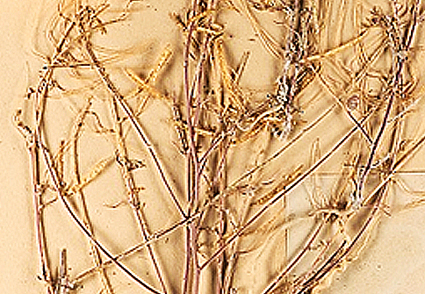Abstract
Cleome Linnaeus (1753: 671), in its traditional sense, is the largest genus of the family Cleomaceae Bercht. & Presl, comprising 200–300 species (Hall 2008, Patchell et al. 2014, Soares Neto et al. 2022, POWO 2024) which are native to the tropical, subtropical, and arid regions of both hemispheres (Patchell et al. 2014, Mousa 2019, Shilla et al. 2019, Roalson 2021, POWO 2024).
References
- Barrett, R.L., Roalson, E.H., Ottewell, K., Byrne, M., Govindwar, S.P., Yadav, S.R., Tamboli, A.S. & Gholave, A.R. (2017) Resolving generic boundaries in Indian-Australasian Cleomaceae: circumscription of Areocleome, Arivela, and Corynandra as distinct genera. Systematic Botany 42: 694–708. https://doi.org/10.1600/036364417X696401
- Bobrov, E.G. (1939) Capparidaceae Lindl. In: Komarov, V.L. (Ed.) Flora of the U.S.S.R., vol. 8. Capparidaceae, Cruciferae and Resedaceae. Moscow-Leningrad: Izdatel’stvo Akademii Nauk SSSR, pp. 1–14; 633–634.
- Feodorova, T.A., Voznesenskaya, E.V., Edwards, G.E. & Roalson, E.H. (2010) Biogeographic patterns of diversification and the origins of C4 in Cleome (Cleomaceae). Systematic Botany 35 (4): 811–826. https://doi.org/10.1600/036364410X539880
- Hall, J.C. (2008) Systematics of Capparaceae and Cleomaceae: an evaluation of the generic delimitations of Capparis and Cleome using plastid DNA sequence data. Botany 86 (7): 682–696. https://doi.org/10.1139/B08-026
- Hedge, I. & Lamond, J. (1970) Cleome. In: Rechinger, K.H. (Ed.) Flora Iranica, vol. 68. Academische Druck-und Verlagsanstalt, Graz, pp. 13–30.
- Iltis, H.H. & Cochrane, T.S. (2007) Studies in the Cleomaceae V: A new genus and ten new combinations for the Flora of North America. Novon 17 (4): 447–451. https://doi.org/10.3417/1055-3177(2007)17[447:SITCVA]2.0.CO;2
- JACQ (2024) the jointly administered herbarium management system and specimen database. Available from: https://www.jacq.org/detail.php?ID=234813 (accessed 13 March 2024)
- Linnaeus, C. (1753) Species Plantarum, vol. 2. Laurentius Salvius, Stockholm, 639 pp.
- Mousa, M.O. (2019) Systematic study for the new record Cleome scaposa DC. (Cleomaceae) in Iraq. Plant Archives 19: 1170–1177.
- Patchell, M.J., Roalson, E.H. & Hall, J.C. (2014) Resolved phylogeny of Cleomaceae based on all three genomes. Taxon 63 (2): 315–328. https://doi.org/10.12705/632.17
- POWO (2024) Plant Of the World Online. Abvailable from https://powo.science.kew.org/taxon/urn:lsid:ipni.org:names:147363-1 (accessed 13 March 2024)
- Roalson, E.H. & Hall, J.C. (2017) New generic concepts for African Cleomaceae. Systematic Botany 42 (4): 925–942. https://doi.org/10.1600/036364417X696393
- Roalson, E.H. (2021) A revised synonymy, typification, and key to species of Cleome sensu stricto (Cleomaceae). Phytotaxa 496 (1): 54–68. https://doi.org/10.11646/phytotaxa.496.1.2
- Saghafi-Khadem, F. (2000) Flora of Iran, Capparaceae. Research Institute of Forest and Rangelands (RIFR), Tehran, 49 pp.
- Shilla, O., Dinssa, F.F., Omondi, E.O., Winkelmann, T. & Abukutsa-Onyango, M.O. (2019) Cleome gynandra L. origin, taxonomy and morphology: A review. African Journal of Agricultural Research 14 (32): 1568–1583. https://doi.org/10.5897/AJAR2019.14064
- Soares Neto, R.L., Thomas, W.W., Roalson, E.H. & de Vasconcellos Barbosa, M.R. (2022) Taxonomic revision of Tarenaya (Cleomaceae). Annals of the Missouri Botanical Garden 107 (1): 250–313. https://doi.org/10.3417/2022705
- Thiers, B. (2024 [contonuously update]) Index Herbariorum, A global directory of public herbaria and and associated staff. New York Botanical Garden’s Virtual Herbarium. Available from: http://sweetgum.nybg.org/ih/; http://sweetgum.nybg.org/ih/ (accessed 13 March 2024)
- Thulin, M. & Roalson, E.H. (2017) Resurrection of the Genus Rorida (Cleomaceae), a Distinctive Old World Segregate of Cleome. Systematic Botany 42 (3): 569–577. https://doi.org/10.1600/036364417X695989
- Turland, N.J., Wiersema, J.H., Barrie, F.R., Greuter, W., Hawksworth, D.L., Herendeen, P.S., Knapp, S., Kusber, W.-H., Li, D.-Z., Marhold, K., May, T.W. & McNeill (Eds.) (2018) International Code of Nomenclature for algae, fungi, and plants (Shenzhen Code) adopted by the Nineteenth International Botanical Congress Shenzhen, China, July 2017. Regnum Vegetabile 159. Glashütten: Koeltz Botanical Books. https://doi.org/10.12705/Code.2018


